Sig Sauer 1911 .45 ACP Stainless Finish with Blackwood Grips 1911R-45-SSS For Sale
$1,011.97
Is the SIG Sauer 1911 good?
The SIG Sauer 1911 is generally considered a good firearm by many enthusiasts and experts. It is praised for its solid build quality, reliability, and accuracy. The craftsmanship and materials used are often noted as being of high quality, and the design incorporates modern enhancements while maintaining the classic 1911 look and feel. However, personal preferences vary, so it’s important for potential buyers to assess their own needs and, if possible, test the firearm to ensure it meets their expectations.
What Sig Sauer do Navy SEALs use?
Navy SEALs primarily use the Sig Sauer P226 as their standard sidearm. Recently, some units have transitioned to the newer Sig Sauer P320, known as the M18 in military service, as part of the U.S. military’s broader adoption of this model.
Is kimber or sig better?
The answer to whether Kimber or SIG Sauer is better depends on individual preferences, needs, and specific use cases. Both companies produce high-quality firearms with distinct features:
– **Kimber** is well-regarded for its 1911-style pistols, known for precision craftsmanship, aesthetic appeal, and accuracy. They are often favored by users who prioritize the traditional 1911 experience and custom-quality finishes.
– **SIG Sauer** offers a wide range of firearms, including the popular P320 and P365 series. SIGs are known for their reliability, advanced features, and modularity. They often appeal to those who value modern designs and innovation.
It’s important to evaluate factors like intended use (e.g., concealed carry, competition, home defense), ergonomics, budget, and personal handling to determine which brand or specific model might be better suited to your needs. Testing different models at a range can also provide valuable insights.
Why is SIG Sauer so expensive?
SIG Sauer firearms are often considered expensive for several reasons:
1. **Quality and Craftsmanship**: SIG Sauer is known for its high-quality materials and meticulous craftsmanship, which contribute to the reliability and durability of their firearms.
2. **Precision Engineering**: The company invests heavily in precision engineering and advanced manufacturing techniques, resulting in firearms that perform well under various conditions.
3. **Innovation**: SIG Sauer consistently innovates, incorporating advanced technology and features into their products. This ongoing research and development can drive up costs.
4. **Reputation**: The brand has a strong reputation among both civilian and professional users (including military and law enforcement), which can justify premium pricing.
5. **Testing and Standards**: SIG Sauer firearms are subjected to rigorous testing and meet or exceed industry standards, ensuring performance and safety. This level of quality assurance comes at a cost.
6. **Materials**: The use of high-grade materials, such as superior alloys and high-strength polymers, adds to the cost of production.
7. **Limited Production**: Some models are produced in limited quantities, which can increase their rarity and price.
8. **Warranty and Support**: The company offers robust customer service and warranty support, which adds value but also contributes to the overall cost.
These factors combined contribute to SIG Sauer’s positioning as a high-end firearm manufacturer, often resulting in higher prices compared to some competitors.
Is 1911 or Glock more reliable?
Both the 1911 and Glock firearms have strong reputations for reliability, but their performance can vary based on several factors, including maintenance, ammo quality, and specific model variations. Generally speaking:
– **Glock:** Known for its simplicity, fewer parts, and polymer construction, Glocks are often praised for their reliability under adverse conditions. Their design requires minimal lubrication and maintenance, which can contribute to consistent performance.
– **1911:** This platform has been around for over a century and is renowned for its ergonomics and precision. However, the 1911 typically requires more maintenance and attention to detail to ensure reliability, particularly with some modern variations or lower-quality reproductions.
Ultimately, when comparing the two, Glock firearms are often considered more consistently reliable across various conditions without needing extensive upkeep. However, a well-maintained 1911 can also be highly reliable. The choice between the two often comes down to personal preference and the specific requirements of the user.
Where is Sig Sauer 1911 made?
The Sig Sauer 1911 is primarily manufactured in Newington, New Hampshire, USA.
What pistol does the FBI use?
The FBI primarily uses the Glock 19M and Glock 17M pistols. These are 9mm handguns designed to meet the agency’s requirements for reliability, durability, and performance.
Why did the SEALs drop the SIG P226?
The U.S. Navy SEALs transitioned from the SIG P226 to the Glock 19 as part of a broader effort to modernize and standardize their equipment. Several reasons contributed to this change:
1. **Size and Weight**: The Glock 19 is generally lighter and more compact than the SIG P226, making it easier to handle and carry, particularly in challenging operational environments.
2. **Durability and Reliability**: Glocks are renowned for their durability and reliability in adverse conditions. The SEALs likely opted for the Glock 19 due to its proven performance in diverse environments.
3. **Modularity and Simplicity**: The Glock 19 features a simpler design with fewer parts, easing maintenance and reducing the likelihood of malfunctions. Its modularity also allows for easier customization and upgrades.
4. **Commonality**: The Glock 19 is widely used across various U.S. military branches and law enforcement agencies, promoting interoperability and simplifying logistics, training, and supply chain management.
These factors collectively made the Glock 19 an attractive option for the SEALs, leading them to adopt it over the SIG P226.
What pistol do marines carry?
The U.S. Marines typically carry the M18 service pistol, which is a variant of the SIG Sauer P320. The M18 has been adopted as part of the military’s Modular Handgun System program.
Why are Kimber 1911 so expensive?
Kimber 1911 pistols are often considered expensive due to several factors:
1. **Quality and Craftsmanship**: Kimber is known for its high standards of manufacturing, precision engineering, and attention to detail. Their 1911 models are crafted with high-quality materials and tight tolerances, which contribute to both performance and durability.
2. **Performance Features**: Kimber 1911s often come with features that enhance their performance and usability, such as match-grade barrels, high-grade triggers, and customizable options. These add to the manufacturing cost but also improve the shooting experience.
3. **Brand Reputation**: Kimber has established a reputation for producing premium firearms that appeal to enthusiasts and professionals alike. This reputation can justify a higher price point due to the perceived value associated with the brand.
4. **Customization and Options**: Kimber offers a wide range of custom options and finishes that allow buyers to tailor the firearm to their preferences. This level of customization often increases the cost compared to standard models.
5. **Limited Production and Models**: Some Kimber 1911 models are produced in limited numbers, which can drive up prices due to their scarcity and collectibility.
Overall, the combination of quality, performance, brand reputation, customization options, and limited production contributes to the higher price of Kimber 1911 pistols.
Is SIG better than Glock?
The question of whether SIG is better than Glock is subjective and depends on various factors, including personal preferences, specific use cases, and individual requirements. Here are some points to consider for both:
– **SIG Sauer**:
– Known for high-quality craftsmanship and reliability.
– Offers models like the P320 and the classic P226, which are popular for their modularity and durability.
– Often preferred by those who prioritize ergonomics and a solid feel in a handgun.
– **Glock**:
– Renowned for its simplicity, reliability, and ease of maintenance.
– Glocks, such as the Glock 17 and Glock 19, are popular for their lightweight, polymer frames and widespread use among law enforcement.
– Frequently chosen by those who value practicality and consistency.
Ultimately, the “better” choice comes down to personal preference, intended application (self-defense, competition, law enforcement, etc.), and which firearm fits best in terms of ergonomics and usability for the individual. It is advisable to try out different models from both brands to determine which one suits you best.
What is the most popular Sig Sauer?
The most popular Sig Sauer firearm is often considered to be the Sig Sauer P320. This modular, striker-fired pistol has gained widespread popularity due to its versatility, reliability, and adoption by various military and law enforcement agencies, including the U.S. Army.
Why is SIG SAUER closing?
There isn’t any publicly available information indicating that SIG SAUER is closing as of my last update in October 2023. SIG SAUER is a well-known firearms manufacturer, and while companies can undergo operational changes or restructuring, such developments would typically be announced through official press releases or news outlets. For the most current details, it’s recommended to check the latest news reports or the company’s official communications.
Which SIG SAUER has issues?
There have been reports of issues with the SIG SAUER P320 model. Some users have raised concerns about unintentional discharges under certain conditions. It’s important to refer to official sources or SIG SAUER for the latest information and any potential recalls or safety notices.
Do SEALs prefer Glock or SIG?
U.S. Navy SEALs have historically used a variety of firearms, but in recent years, they have preferred the SIG Sauer P226 and P229 pistols over Glock models. The SIG Sauer P226 was the standard issue sidearm for a long time, although there is interest in updating and incorporating different models. The preferences might vary based on operational requirements and updates in procurement.
Be the first to review “Sig Sauer 1911 .45 ACP Stainless Finish with Blackwood Grips 1911R-45-SSS” Cancel reply
Related products
Sig Sauer 1911
Sig Sauer 1911 .45 ACP Black Nitron Finish Night Sights with Rosewood Grips 1911R-45-BSS
Sig Sauer 1911
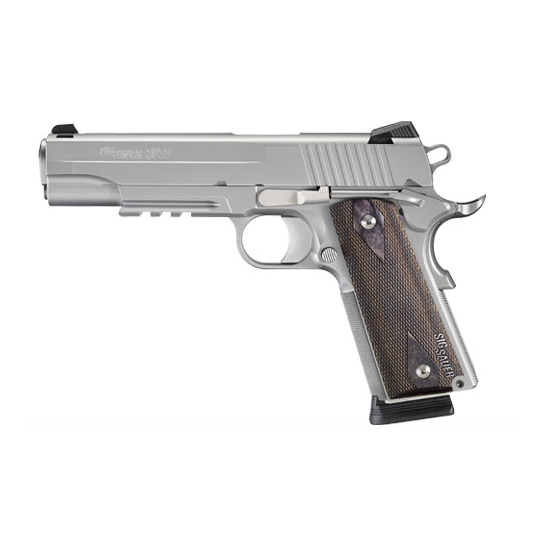
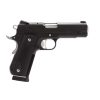
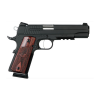
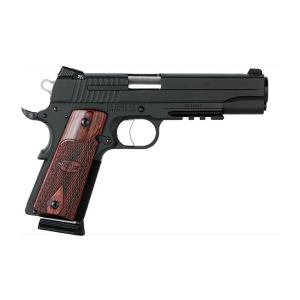
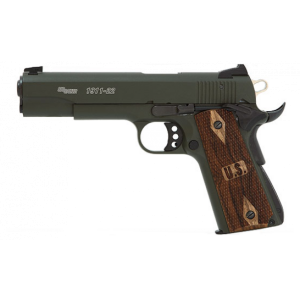
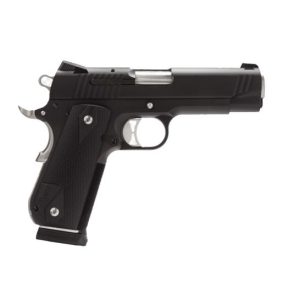
Reviews
There are no reviews yet.